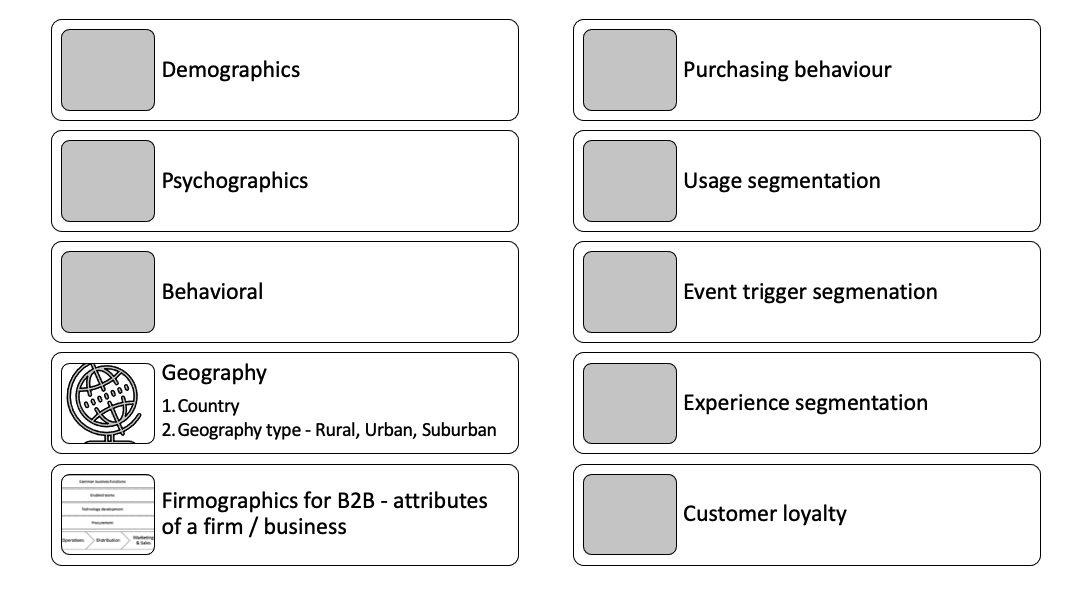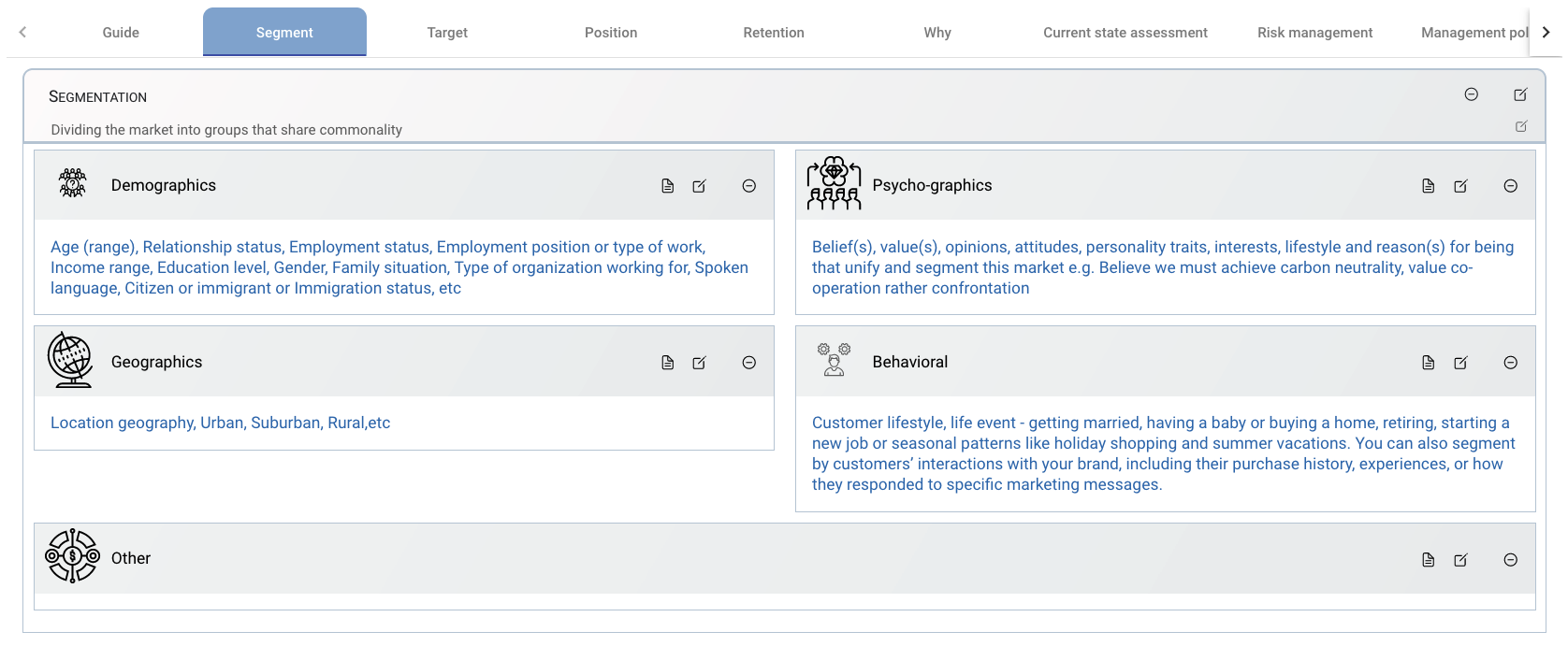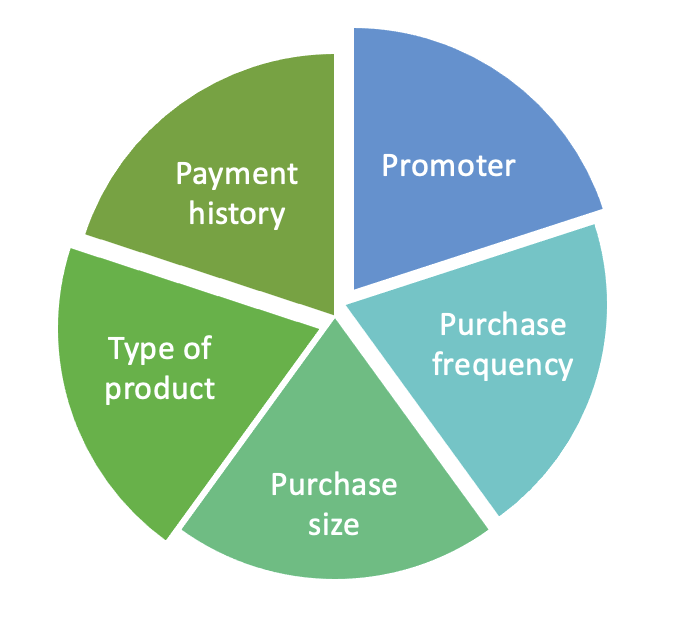Designing for superior business performance
A guide for technology, creative and startup leaders
"if you love what you're doing and you always put
the customer first, success will be yours.”
Ray Kroc.
Choice 3: Delight we create / Which customers
In this section
Use the Segmentation, Targeting and Position method to identify customers, the value proposition can be communicated to and succeed with.
Identify the outcomes required of this value proposition choice
-
Apply Segmentation, Target and Positioning methods and knowledge to define accessible (viable cost of acquisition) customer segments.

What outcomes are required?
The which customers strategic choice clarifies these important criteria for your strategic choices / your business blueprint
-
Which customers have the need and are willing to pay for the value or delight that your value proposition delivers?
-
Do those candidate customers experience the situations identified in the Jobs to be Done
-
Are those customers accessible to the business and via which channels?
-
Are there enough of those customers to be delighted, to justify the investment necessary or prove the value of the value proposition.
In some cases your value proposition might be targeted at a smaller market to win that market with the intent of expanding the influence of your value proposition.
Keeping the which customers choice clearly defined enables you to
-
Ensure your value proposition is or can address the needs and desires of customer groups
-
Design your product(s) and/or service(s) to best meet those needs and desires
-
Discover and deliver opportunities to optimize the customers journey or experience based upon shared attributes of those groups.
-
Develop a marketing or communications strategy to reach a market open to your message.
Market segmentation
What is a market segment
A market segment is a sub-section of all of the market / society that shares a common set of characteristics. It is that common set of characteristics that a business anticipates and ideally validates has the need or desire for its value proposition. When Louis Vuitton thinks about its market segment it is targeting those who are fashion conscious, have a desire to own, use and potentially demonstrate beautiful fashion and accessories and so forth. This is likely a very different sub-section of society to that being targeted by KIA the car company and McDonalds the restaurant. Segmentation can be done across multiple different and a combination of dimensions including:



In all cases it is a person or people who make the choice to be willing to pay for and experience delight from your value proposition. So even if a business is trading B2B it still needs to offer people value and delight. Businesses do not buy products and services people do.
Why market segmentation
Market segmentation is a performance and productivity improvement tool.
It enables your business to be more efficient in terms of time,
money and other resources when communicating your offering,
your value proposition.
You can tailor your message, so it resonates with that customer segment.
If for example a business is selling Database management software,
then the message targeting technical personnel will be different to the
message communicated to C-suite executives.
The message must be different as the needs of the technical personnel are
different from those of C-suite.
Channels for communicating the message will also likely vary.
Technical personnel might be accessible via platforms such as Youtube,
Technology websites.
The C-Suite executives might be more accessible via direct sales,
business journals and so forth.
Market segmentation also allows companies to learn about their customers more specifically.
Getting feedback from the technical teams on your product is a focused set of feedback.
Getting feedback from a broader market segment with varied and undefined needs
is likely to result in an incomprehensible and unactionable set of feedback.
The better understanding of customer’s needs and wants allows focused
communications to each customer segment and product improvements most likely
to be valuable.
Now you are up-to-date on the why of market segmentation, you can review the how.
Demographic segmentation
Demographic segmentation is the segmentation of a population-based on factors you would expect in a government census including attributes such as age, race, and sex, employment, education, income, marriage or relationship status and more. Recalling the needs satisfied by your value proposition which demographic factors would identify the people in society that are mostly likely to have those needs?
| Age range | Relationship status | ||
|---|---|---|---|
| Gender identity | Family situation | ||
| Employment situation |
[insert employment position in here as relevant] |
Income range | |
| Education level | Type of organization working for |
[insert type in here as relevant] |
|
| Immigration status | Nationality | ||
| Country | Region |
Urban | Suburban | Rural | etc |
|
Psycho-graphic segmentation
Psycho-graphic segmentation is segmentation of a population-based on factors such on their interests, activities, personal values, and lifestyle choices. The best to start your psychographic segmentation is to discover the interests, hobbies, and lifestyle choices of your customers through dialog – call it an interview or discussion.
| Lifestyle | Social status identity |
What social status does the segment identify as |
|
|---|---|---|---|
| Values and attitudes |
[insert values possessed by your target customers in here as relevant – Achievement oriented, Bold, Calm, Competitive, Co-operative, Freedom, Fun, Growth, Happiness, Honesty, Quality, Security, Speed] |
Personality traits - |
[Introvert Extrovert, Friendly, Emotional, Funny, Opinionated, Stoic ] |
| Interests |
[interests common to this segment] |
Concerns |
Things that concern this segment |
| Influenced by | Other |
[insert anything else in here as relevant] |
Behavioural segmentation
Behavioural segmentation is the segmentation of a population-based on factors such on their interests, activities, and lifestyle choices. The best to start your psychographic or behavioural segmentation is to discover the interests, hobbies, and lifestyle choices of your customers through dialog – call it an interview or discussion.
Purchase behaviour
Purchase behaviour-based segmentation looks at how customers act differently throughout the decision-making process. It helps businesses understand:
How customers approach the purchase decision
The complexity of the purchasing process
The customer’s role in the purchasing process
Barriers along the path to purchase
Which behaviors are most and least predictive of purchase-making
Purchasing behaviour can be broken down into four main categories:
| Complex | Variety |
|---|---|
| A customer is highly involved in the purchasing and decision-making process, and there is a significant difference between the offers being considered. Examples include purchase of new luxury car, a new home, or a new Enterprise Resource Planning system for a fortune 500 company – a bad decision has ramifications | The customer isn’t too involved in the purchasing process, but there’s still a difference in the offers from different businesses. There is less at personal stake for the customer here and often the duration of the impact of the decision is shorter e.g., decided to try a new brand of coffee, pizza shop or similar. Businesses can enable this type of purchasing behaviour by providing trials, test drives, leases, rental arrangement and so forth to increase the confidence or decrease the durability of the decision. |
| Dissonance-reducing | Habitual |
| Customer is making an important purchasing decision, that could impact them personally, but they perceive the choices to be similar or undifferentiated. For example, when purchasing a new dining table, silverware set, or recruitment agency a customer might base their decision on price rather than the different attributes of the product | When a purchase doesn’t require much involvement, the product being offered doesn’t vary much across brands, and it’s mainly a personal preference or habit – the customer always buys that brand e.g. purchase the same laundry detergent or order pizza’s for the staff from the same nearby pizza shop. |
Buyer journey or stage
A frequent cause of losing customers is to seek a commitment when it is too early in the relationship,
a bit like popping the engagement ring into the champagne glass on the first or second date (without being a teenage Hollywood celebrity).
The aim of Buyer journey stage segmentation is present value proposition
to the prospective customer based
upon the knowledge and level of commitment they can make based upon where they are.
Moreover, when we evaluate accessibility to the market segment, you can
consider if the prospective customers are accessible to your business
depending on the buying stage. For example, buyers late in the stage might be
difficult to access as their minds are closed to
more information. It can be easier to identify where a prospect is in
the buyer journey with qualifying questions .
Examples below
| PROMPT FOR THE CUSTOMER TO RESPOND TO | LIKELY BUYER STAGE |
|---|---|
| Looking to understand more about the benefits of a CRM system? | Likely early in the journey – aim to inform the prospective customer of the benefits and roadmap and offer to partner with the customer in their evaluation |
| Still looking for the right CRM system? Overwhelmed by too many CRM options? | Further in the buyer journey but undecided |
| Has your CRM been underperforming for too long now? | Likely experienced with CRM systems but may be looking to make a change |
Usage segmentation
Usage segmentation aims to segment a market based upon the type of
usage the customer will make of the value proposition.
As an example, consider, power tools.
Power tools might be purchased by professionals and the occasional
weekend Do-it-yourselfer.
Putting together a compelling value proposition with superior performance,
low total cost of ownership, durability and reliability is likely
less valuable to the occasional DIYer,
but much more valuable to the heavy professional usage person.
Consider a second example software. Software consumer of a business
automation solution for use in a non-critical low value
business process will be in a different segment that those looking to use it
in high volume, business essential process automations.
Usage segmentation considers:
How customers are using your product or service
How often they use it
How much time they spend with it
What features they use
How many users from the same account use it?
Usage-based segments can include:
-
High frequency / importance users - Customers that most depend upon and spend the most time using your product or service, and purchase most frequently
-
Medium frequency / importance users - Customers that regularly, but not very frequently, use or purchase your products (often time- or event-based – tax time, seasonal
-
Low frequency / importance users- Customers that use or purchase much less than other customers, sometimes even only once
Event trigger
Event trigger segmentation aims to segment a market based upon the types of trigger events that drive the desire for the value proposition of your business. If you sell Pizza’s then Friday night might be a trigger or the day of the football finals. If you sell CRM systems, then the appointment of a new CEO, marketing executive or loss of a major account might be a trigger to stimulate the need. Finally, if you are retailer then festive seasons are a recurring event trigger.
Experience segmentation
Experiences is another way to segment customers behaviorally. Some of the most common include:
| Category of experience | Description |
|---|---|
| No awareness and no experience | May need to be made aware that they have a problem in the first place |
| Some awareness and no experience | Need to learn why your product or service is their best option |
| First-time usage | Might need further instruction on how to get the most value from your product |
| Regular users | Ongoing nurture of the relationship Maybe candidates for product development growth via supplemental products or services you offer |
| Toward defectors | Customers dissatisfied with a competitor who might go back to the originating brand fixes the issue that caused them to leave. Alternatively, a competitor maybe in service delivery, reputation or other trouble and there is the chance to offer their existing customers salvation |
| Away defectors | Former customers who have switched to a competitor who might come back to your brand if you’ve fixed the reason for them leaving |
| Non-customers | Potential customers who have the need, but their unfavorable experiences have made them non-customers |
Customer loyalty

Customer loyalty is technical part of a customer segment. A Customer segment is how you might partition your existing customers. It is mostly an academic difference because you will frequently segment customer segments as you would a market segment, but customer loyalty, purchase frequency, purchase amounts, customer satisfactions are additional segmentations for existing customers. There could be multiple ways to partition customers based upon loyalty including:
Promoter
Promoter of your business (> 8 on a Net Promoter Score)
Detractor (<7 on a Net promoter score)
Neutral (neither positive nor negative 7 or 8 on Net Promoter Score)
Purchase frequency:
High purchase frequency
Medium purchase frequency
Low purchase frequency
Purchase size:
Large purchase
Medium purchase
Low purchase
Type of product
Premium
Standard
Payment history
Reliable / timely
Unreliable / untimely
Segments a B2B market based upon the type of organizations being targeted e.g., Fortune 50, 500, SME, start-ups, government, non-government and so on. Organizations can be segments based upon:
Industry(ies) operated in e.g. the Chemical engineering industry versus the Pharmaceutical industry
Location or Geography
Size (e.g. number of employees)
Structure (public companies, privately held, fortune 500 or 2000)
Status – market leaders, aspiration leaders, startups, favorable reputation
Performance (Growing, Stagnant, Declining, Gained a particular round of venture capital)
Wrapping up the segment definition
At this point, you have been able to define one or more target segments based upon demographic, psychographic, behavioral, usage, event triggers, loyalty, and even firmographic attributes. The attributes of one or more target segments are now well defined. The remaining questions are can your business access and target these segments and if so, how will it do so? To answer these questions in the next sections, you can assess targeting feasibility and positioning approaches to win with your specified segments.
| Purchasing behavior |
[insert purchasing behavior you anticipate prospective / customers will use as relevant] |
Benefits sought |
[insert relationship status in here as relevant] |
|---|---|---|---|
| Buyer stage |
[insert buyer stages in here as relevant] |
Experiences |
[insert experiences of the segment in here as relevant] |
| Usage | |||
| Usage scenario |
[High | Medium | Low] |
Features |
[Product attributes that matter most based upon usage scenario] |
| Event triggers | |||
| Specific event | Recurring situations |
[insert anything else in here as relevant] |
|
Wrapping up the segment definition
At this point, you have been able to define one or more target segments based upon demographic, psychographic, behavioral, usage, event triggers, loyalty, and even firmographic attributes. The attributes of one or more target segments are now well defined. The remaining questions are can your business access and target these segments and if so, how will it do so? To answer these questions in the next sections, you can assess targeting feasibility and positioning approaches to win with your specified segments.
Continue on the segment targeting
Advance your strategy productivity
Define, refine and implement your strategy faster, easier and better
Build your unique value delight proposition in StrategyCAD™
Try it Learn moreYou can try StrategyCAD™ free for 30 days to build your high performance strategy